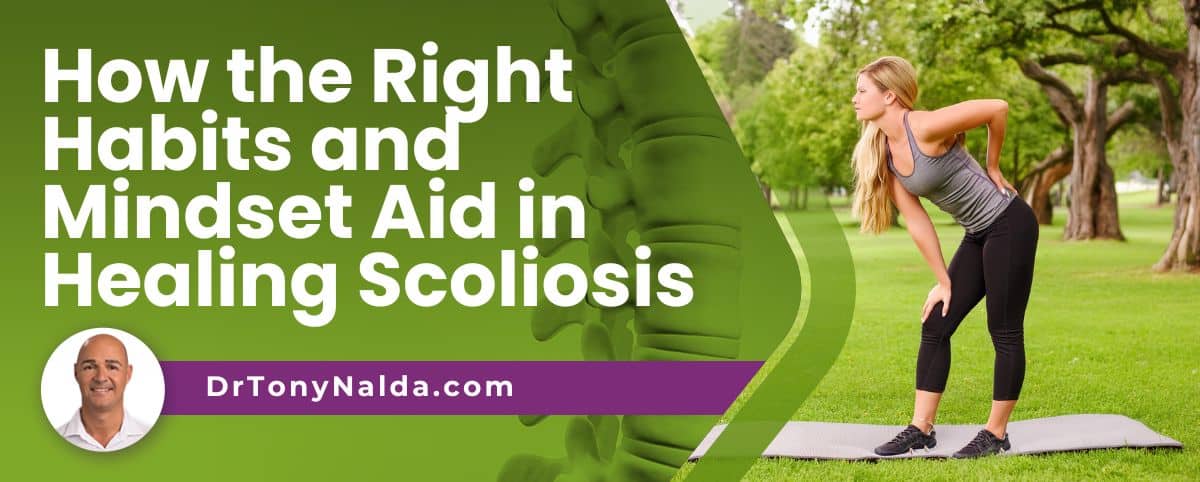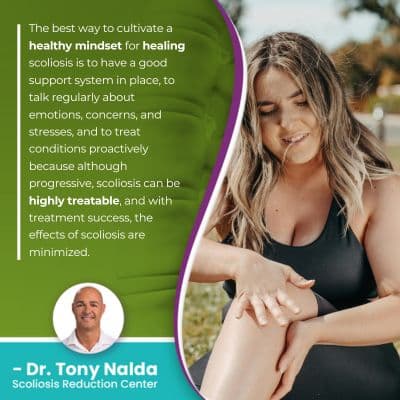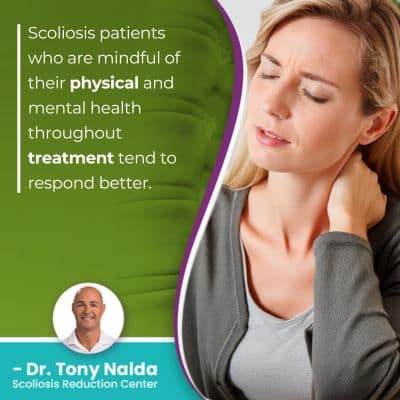How the Right Habits and Mindset Aid in Healing Scoliosis

Having a healthy mindset is important for everyone, but for patients recently diagnosed with a progressive spinal condition, it can mean the difference between being able to handle the rigors of scoliosis treatment, or not being able to follow through with a specific phase of treatment.
Scoliosis treatment has to treat the whole patient for the best results, and mental health is an important part of being responsive to treatment. Being mindful of attitude, lifestyle choices, and overall well being can help create an environment inside the body that's more conducive to healing.
Adolescents are most commonly diagnosed with scoliosis, and this age group is most likely to deal with body image issues, so let's focus on the power of a healthy mindset for adolescent idiopathic scoliosis patients.
Table of Contents
Adolescent Idiopathic Scoliosis
When scoliosis is first diagnosed, it has to be further classified based on a number of important variables: patient age, condition type, severity, and curvature location.
Scoliosis causes an unnatural sideways-bending and rotating spinal curvature to develop, and as a progressive condition, its nature is to get worse over time.
Scoliosis patients need treatment that focuses on maintaining spinal health, but there is also the topic of mental health to address throughout treatment and beyond.
Scoliosis affects all ages from babies born with congenital scoliosis to infantile scoliosis, early-onset juvenile scoliosis, adolescent scoliosis, and adult scoliosis is diagnosed once skeletal maturity has been reached.
Adolescent idiopathic scoliosis patients are between the ages of 10 and 18, and even typical adolescents, without scoliosis, are known to struggle with negative aspects of mental health, body image, and self esteem issues; add to that a diagnosis of a progressive spinal condition capable of changing a teen's posture, gait, balance, coordination, and the way clothes fit, and there is an added element of challenge.
As a progressive condition, where an adolescent's scoliosis is at the time of diagnosis doesn't mean that's where it will stay.
Even if diagnosed with mild scoliosis and there are no noticeable effects, it's important to understand that when/if scoliosis progresses, its effects become more noticeable, along with making the condition more complex to treat.
So let's address the physical changes that scoliosis can cause in adolescents as these can be the most stressful for young people who generally want to fit in with their peers, not stand out.
Adolescent Scoliosis, Posture, and Body Image
Scoliosis ranges widely in severity, so no two cases are the same.
Scoliosis ranges from mild scoliosis to moderate scoliosis, severe and very severe scoliosis, and the more severe scoliosis is, and the longer it's left untreated, the more likely it is to develop potential complications.
With adolescents, often the earliest signs of scoliosis are uneven shoulders and hips, but these are just the beginning of postural changes that can occur, particularly in severe cases and/or when left untreated.
Additional changes can include:
- An uneven eye line
- The head not centered over the torso
- Uneven shoulder blades
- The development of a rib cage arch
- Arms and legs that appear to hang at different lengths
- Uneven waistline
- Muscle imbalances
- General poor posture
 The aforementioned changes can also be accompanied by changes to movement: disruptions to balance, coordination, and gait.
The aforementioned changes can also be accompanied by changes to movement: disruptions to balance, coordination, and gait.
Considering an average adolescent wants to blend in with their peers, they don't want to look or move differently, a scoliosis diagnosis can be extremely concerning, and the mental effects of scoliosis can't be discounted.
Thoughts of self-harm are more prevalent in adolescents with health conditions that affect their appearance; negative self image and body issues are rampant in modern culture thanks, in part, to social media, and the pressure on teens to have the perfect body and look.
A difficult part of the diagnosis is hearing that as a progressive condition, there is no curing scoliosis; treatment is more about how best to manage an ongoing condition so patients can lead fulfilling lives, which is more than possible!
I like to give young patients recently diagnosed examples of famous athletes and celebrities that despite having scoliosis have gone on to fulfill their life's goals and dreams as there are many stories of inspiration with motivational benefits.
The best way to cultivate a healthy mindset for healing scoliosis is to have a good support system in place, to talk regularly about emotions, concerns, and stresses, and to treat conditions proactively because although progressive, scoliosis can be highly treatable, and with treatment success, the effects of scoliosis are minimized.
Treatment Success and Healthy Habits
There is nothing more motivating for an adolescent than to see their body responding to treatment.
While adolescent idiopathic scoliosis doesn't have a single-known cause, we do know what triggers it to progress: growth.
So adolescents are also the most at risk for rapid-phase progression due to the stage of puberty with its rapid and unpredictable growth spurts.
Having a healthy mindset can help adolescents better handle the rigors of treatment. Here at the Scoliosis Reduction Center, my intensive treatment approach doesn't mean invasive or painful, but it does involve short-duration high-dose treatment that while demanding, has the potential to deliver impressive results; having a good attitude and healthy habits in place can help.
Staying active and making scoliosis-friendly lifestyle choices can help make the body more responsive to treatment and can strengthen the mild simultaneously.
Along with the physical demands of treatment, the mental demands shouldn't be underestimated, and this is where a healthy mindset comes in; I see such a difference in treatment efficacy in patients who have good attitudes and are willing to push through the initial phases of treatment until results can be seen, and results can include curvature reductions, core muscles becoming stronger so the spine is better supported/stabilized, and rehabilitation.
 Posture awareness is important, and patients who are receptive to making changes to how they hold themselves, are mindful of forward head posture during screen time, and balance their weight while walking are likely to respond better to our efforts to correct posture.
Posture awareness is important, and patients who are receptive to making changes to how they hold themselves, are mindful of forward head posture during screen time, and balance their weight while walking are likely to respond better to our efforts to correct posture.
Curve progression can be counteracted with a proactive conservative treatment plan, and this involves condition-specific chiropractic care, physical therapy, corrective bracing, and rehabilitation.
When integrated into a proactive and customized treatment plan, and particularly with early detection and intervention, there are fewer limits to what can be achieved.
Healthy habits can help create an environment inside the body that's more conducive to healing include a healthy activity level to keep the body strong, the spine strong and flexible, the spine's surrounding muscles strong and supportive, a healthy diet, weight, and a healthy mindset.
Scoliosis patients who are mindful of their physical and mental health throughout treatment tend to respond better.
Conclusion
A physical examination is important for gauging a patient's physical ability to handle the rigors of treatment, but it's also important for me to take the time to assess a young patient's potential mental health.
A patient's mental health is a key factor in how receptive they are to instructions, how thorough they are in making scoliosis-friendly lifestyle choices, and how capable they are of handling the challenge of a scoliosis diagnosis.
For the parents, families, and friends of adolescents recently diagnosed, it's important to be aware of the condition's effects, including its potential mental-health effects; knowing what to say, and what not to say, can help, and this is something I'm happy to provide guidance on.
When a patient commits to my treatment approach, I also commit to them; I'm here for the entirety of their scoliosis-treatment journey, and that can include providing patients, families, and parents with resources and guidance on how to safeguard the mental health of young patients recently diagnosed.
Surgical intervention can be an option, but many adolescents are disappointed with the cosmetic results of scoliosis surgery as spinal fusion focuses solely on the spine, not its surroundings, and doesn't specifically target postural changes; in addition, a fused spine can be more painful, less flexible, and is weaker and more vulnerable to injury, and these factors can introduce new mental stressors for young people.
A conservative nonsurgical treatment response has impressive results, proving that not all cases of scoliosis require surgical treatment.
Do you have the right habits and mindset for healing scoliosis? If you are practicing a healthy spine-friendly lifestyle that involves maintaining a health weight, diet, activity level, self-care for mental health benefits, and most importantly, are getting proactive treatment, success is more likely.
Dr. Tony Nalda
DOCTOR OF CHIROPRACTIC
After receiving an undergraduate degree in psychology and his Doctorate of Chiropractic from Life University, Dr. Nalda settled in Celebration, Florida and proceeded to build one of Central Florida’s most successful chiropractic clinics.
His experience with patients suffering from scoliosis, and the confusion and frustration they faced, led him to seek a specialty in scoliosis care. In 2006 he completed his Intensive Care Certification from CLEAR Institute, a leading scoliosis educational and certification center.
About Dr. Tony Nalda
 Ready to explore scoliosis treatment? Contact Us Now
Ready to explore scoliosis treatment? Contact Us Now





